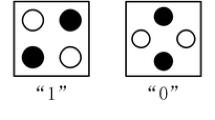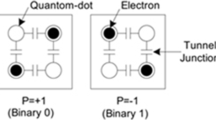Abstract
By the inevitable scaling down of the feature size of the MOS transistors which are deeper in nanoranges, the CMOS technology has encountered many critical challenges and problems such as very high leakage currents, reduced gate control, high power density, increased circuit noise sensitivity and very high lithography costs. Quantum-dot cellular automata (QCA) owing to its high device density, extremely low power consumption and very high switching speed could be a feasible competitive alternative. In this paper, a novel 5-input majority gate, an important fundamental building block in QCA circuits, is designed in a symmetric form. In addition to the majority gate, a SR latch, a SR gate and an efficient one bit QCA full adder are implemented employing the new 5-input majority gate. In order to verify the functionality of the proposed designs, QCADesigner tool is used. The results demonstrate that the proposed SR latch and full adder perform equally well or in many cases better than previous circuits.















Similar content being viewed by others
References
Lent, C.S., Tougaw, P.D., Porod, W., Bernstein, G.H.: Quantum cellular automata. Nanotechnology 4, 49–57 (1993). doi:10.1088/0957-4484/4/1/004
Porod, W.: Quantum-dot devices and quantum-dot cellular automata. Int. J. Bifurcation Chaos 7, 2199–2218 (1997). doi:10.1016/S0016-0032(97)00041-0
Lent, C.S., Tougaw, P.D.: A device architecture for computing with quantum dots. Proc. IEEE 85, 541–557 (1997). doi:10.1109/5.573740
Tougaw, P.D., Lent, C.S.: Logical devices implemented using quantum cellular automata. J. Appl. Phys. 75, 1818–1825 (1994). doi:10.1063/1.356375
Cho, H., Swartzlander, EarlE: Adder and multiplier design in quantum-dot cellular automata. Comput. IEEE Trans. 58, 721–727 (2009). doi:10.1109/TC.2009.21
Zhang, R., Walnut, K., Wang, W., Jullien, G.: A method of majority logic reduction for quantum cellular automata. IEEE Trans. Nanotechnol. 3, 443–450 (2004). doi:10.1109/TNANO.2004.834177
Roohi, A., Sayedsalehi, S., Khademolhosseini, H., Navi, K.: Design and evaluation of a reconfigurable fault tolerant quantum-dot cellular automata gate. J. Comput. Theor. Nanosci. 10, 380–388 (2013). doi:10.1166/jctn.2013.2708
Kamrani, M., Khademolhosseini, H., Roohi, A., and Aloustanimirmahalleh, P.: A novel genetic algorithm based method for efficient QCA circuit design. In: Advances in Computer Science, Engineering & Applications, pp. 433–442. Springer, Berlin (2012) doi:10.1007/978-3-642-30157-5_43
Roohi, A., Khademolhosseini, H., Sayedsalehi, S., Navi, K.: Implementation of reversible logic design in nanoelectronics on basis of majority gates. In: Computer Architecture and Digital Systems (CADS), 16th CSI International Symposium on, IEEE, 2012. doi:10.1109/CADS.2012.6316410
Roohi, A., Menbari, B., Shahbazi, E., Kamrani, M.: A genetic algorithm based logic optimization for majority gate-based QCA circuits in nanoelectronics. Quantum Matter 2, 219–224 (2013). doi:10.1166/qm.2013.1050
Sabbaghi-Nadooshan, R., Kianpour, M.: A novel QCA implementation of MUX-based universal shift register. J. Comput. Electron. 13, 198–210 (2013). doi:10.1007/s10825-013-0500-9
Lu, Y., Lent, C.S.: Theoretical study of molecular quantum-dot cellular automata. J. Comput. Electron. 4, 115–118 (2005). doi:10.1007/s10825-005-7120-y
Rahimi Azghadi, M., Kavei, O., Navi, K.: A novel design for quantum-dot cellular automata cells and full adder. J. Appl. Sci. 7, 3460–3468 (2007)
Navi, K., Sayedsalehi, S., Farazkish, R., Rahimi Azghadi, M.: Five-input majority gate, a new device for quantum-dot cellular automata. J. Comput. Theor. Nanosci. 7, 1546–1553 (2010). doi:10.1166/jctn.2010.1517
Navi, K., Farazkish, R., Sayedsalehi, S., Rahimi Azghadi, M.: A new quantum-dot cellular automata full-adder. Microelectron. J. 41, 820–826 (2010). doi:10.1016/j.mejo.2010.07.003
Akeela, R., Wagh, M.D.: A five-input majority gate in quantum-dot cellular automata. In: NSTI Nanotech, vol. 2, pp. 978–981. (2011)
Toth, G.: Correlation and coherence in quantum-dot cellular automata. Ph.D. Thesis, University of Notre Dame, Notre Dame (2000)
Schulhof, G., Walus, K., Jullien, G.A.: Simulation of random cell displacements in QCA. ACM J. Emerg. Technol. Comput. Syst. (JETC) 3, 2–16 (2007). doi:10.1145/1229175.1229177
Teodosio, T., Sousa, L.: QCA-LG: A Tool for the Automatic Layout Generation of QCA Combinational Circuits, pp. 1–5. Norchip, IEEE, Lisbon (2007). doi:10.1109/NORCHP.2007.4481078
Walus, K., Dysart, T.J., Jullien, G.A., Budiman, R.A.: QCADesigner: a rapid design and Simulation tool for quantum-dot cellular automata. Nanotechnol. IEEE Trans. 3, 26–31 (2004). doi:10.1109/TNANO.2003.820815
Thapliyal, H., Ranganathan, N.: Reversible logic-based concurrently testable latches for molecular QCA. Nanotechnol. IEEE Trans. 9, 62–69 (2010). doi:10.1109/TNANO.2009.2025038
Huang, J., Momenzadeh, M., Lombardi, F.: Design of sequential circuits by quantum-dot cellular automata. Microelectron. J. 38, 525–537 (2007). doi:10.1016/j.mejo.2007.03.013
Dehkordi, M.A., Shamsabadi, A.S., Ghahfarokhi, B.S., Vafaei, A.: Novel RAM cell designs based on inherent capabilities of quantum-dot cellular automata. Microelectron. J. 42, 701–708 (2011). doi:10.1016/j.mejo.2011.02.006
Gin, A., Tougaw, P.D., Williams, S.: An alternative geometry for quantum-dot cellular automata. J. Appl. Phys. 85, 8281–8286 (1999). doi:10.1063/1.370670
Roohi, A., Khademolhosseini, H.: Quantum-dot cellular automata: computing in nanoscale. Rev. Theor. Sci. 2, 46–76 (2014). doi:10.1166/rits.2014.1014
Momenzadeh, M., Jing, H., Tahoori, M.B., Lombardi, F.: Characterization, test, and logic synthesis of and-or-inverter (AOI) gate design for QCA implementation. Comput. Aided Des. Integr. Circuits Syst. IEEE Trans. 24, 1881–1893 (2005). doi:10.1109/TCAD.2005.852667
QCADesigner Home Page. www.atips.ca/projects/qcadesigner
Author information
Authors and Affiliations
Corresponding author
Rights and permissions
About this article
Cite this article
Roohi, A., Khademolhosseini, H., Sayedsalehi, S. et al. A symmetric quantum-dot cellular automata design for 5-input majority gate. J Comput Electron 13, 701–708 (2014). https://doi.org/10.1007/s10825-014-0589-5
Published:
Issue Date:
DOI: https://doi.org/10.1007/s10825-014-0589-5




